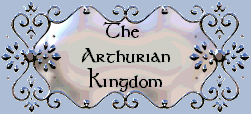The Time
Welcome to the place where you will learn all about the setting the the arthurians lived in, what they did for entertainment, where they lived, and any other interesting facts. Use the links below to take you to where you want to go.


Introduction Life in the middle ages was much, much harder than it is now. By 1200 AD life was more settled than it had been in the past but although Europe was a more settled place it was certainly not peaceful. There were wars, crusades and peasant revolts. There was plague starvation and great contrasts in living standards between rich and poor, certainly no equality.
For most of the population who worked in the countryside life was peaceful most of the time. Trade flourished and towns grew and prospered. New industries were set up and luxury goods reached Europe from the far corners of the world. Skilled craftsmen built magnificent castles and cathedrals.
We know about life in the middle ages from many sources. Thousands of medieval buildings are still standing, and many everyday objects used by both rich and poor people are preserved in museums throughout Europe. Medieval people wrote books and letters about important events as they happened and many of these have survived for us to read. We can also consult the detailed accounts they kept of their business and farming activities. Even some of the poems and songs which delighted medieval audiences have been preserved in manuscripts, so we can listen to them and enjoy them today.
Religion Most people in medieval Europe were very religious. They took their babies to church to be christened and they were buried in the churchyard. Unlike today, the Catholic church was the only church in Europe and all Christians belonged to it. With it's own laws, lands and taxes the Catholic church was a very powerful institution. People knew of other religions and both Judaism and Islam had followers in Europe but all non-Christians were regarded as "infidels" and treated as suspicious. Jews were expelled from England in 1290 and were persecuted in Europe during the fourteenth century. The Catholic church was based at Rome and headed by the Pope. People did occasionally try to set up other churches such as the Cathars in twelfth century France and the Lollards in fifteenth century England. Most people believed though that everyone should believe in one religion and the strongest at that time was the Catholic church, so Christians who opposed the Catholic church were treated harshly. The Cathars for example were condemned by the pope for believing that everything on earth was created by the devil and a crusade against them was launched. In the next 26 years thousands of them were slaughtered until they were all wiped out.
Only certain men could become priests. Serfs were banned, as were the physically impaired although his rule was sometimes relaxed. No women could become priests and men who did become priests were forbidden to marry.
Priests were appointed and controlled by Bishops, the Church's equivalent of noblemen. They owned large, wealthy estates and had their headquarters in cathedrals. The cathedral was by far the largest building in any medieval city. Many of the clergy lived separately to the rest of the population in special religious communities called abbeys or priories. They took vows promising to remain in the abbey for the rest of their lives and to spend their time in prayer study and manual labour. Unlike priesthood this life was open to both men and women. Men became monks and women nuns. Except in a few rare cases all abbeys were single sex communities. Like priests the monks and nuns were forbidden to have children or marry.
As a result of the churches work it became both rich and influential. Anyone who was suspected of disagreeing with the Church's teachings was called a heretic and burnt at the stake. Many believed that even if they did make it to heaven in the afterlife they would have to spend a thousand years in purgatory to be cleansed of their sins on earth ready for the paradise of heaven. So many rich people would pay the church to say extra masses for them in the hope that it would reduce the amount of time in purgatory.
Typical duties for the villagers included farming the lord's land and paying rent to the lord in the form of produce. Criminals were also brought before the lord for swift justice. He had the power to fine those who broke the law. Manors were usually very isolated and as such the villagers had to produce everything they would need themselves. However, a few things such as salt (for curing meat) and iron for tools came from outside. Usually, the only visitors to the manor were travelling salesmen, pilgrims or soldiers, as few people ever left their own village.
Lords and ladies had a great deal of spare time as most of the day to day running of the manor would be left to others. Hunting became one of the main pursuits with many of the gentry keeping hawks and packs of hounds with which to hunt for game in their private woodland. The lord appointed many officials but the most important was the steward. The steward organised the farm-workers and kept records of the estate's money. Also, if the lord of the manor had to go away, the steward had control and presided at the manor court until the lord's return. Stewards were the paid the best and were the most powerful of all the lord's officials.
After the steward came the bailiff. The bailiff was usually a peasant who would wear the same style of clothing as the farm-workers but would have slightly better quality material. The bailiff was a freeholder who owned his own land and it was his role to allot the jobs to the peasants whilst taking care of running repairs to buildings for which he would hire in skilled labourers such as carpenters and blacksmiths.
The lord and his family would live in a large house that was often made of stone. It would include the stables and be surrounded by a wall or moat. The manor house, with the exception of the church, would be the centre of the community. The manor court would be held in its hall, which at other times would be used as the venue for feasts on special occasions such as Christmas and after the harvest. Just like the steward, the bailiff also had a right hand man - he was called the reeve. The reeve was a peasant chosen by the other villagers and it was his job to check that everyone turned up for work on time and that no-one stole any produce from the lord.
According to the law a peasant did not belong to themselves. They and all their belongings: their house, clothes and even their food; was owned by the lord of the manor. Known as serfs or villeins (possibly the root of the modern English word, 'villain', since peasants were generally believed to be up to no good), peasants were bound to work for their lord, who allowed them to farm their own piece of land in return. Their lives were ones of constant toil. Most struggled to produce enough food for their own families as well as fulfilling their duties to the lord of the manor. Forbidden from leaving the manor without permission, the only way for a peasant to gain their freedom was by saving enough money to buy a plot of land, or by marrying a free person.
Clothes, like tools, were mostly home-made from local materials. Peasant women spent much of their time spinning wool into course thread, which was then woven into cloth and made into garments. Sheepskin cloaks were worn in winter to keep out the cold and rain, and wooden patterns could be put on over leather boots in muddy conditions. Although outer clothes were never washed, linen underwear was laundered regularly. People's clothes generally smelled of woodsmoke which had a deodorising effect!
After the black death, plague had killed so many peasants many lords found it increasingly difficult to find enough worker to tend their land. This meant that the surviving peasants knew that they would be in demand no matter where they went and so many of them started to wander the countryside looking for the best paid work. This was very different to the feudal relationship that the peasants had been in up until then and the countryside became very unsettled. Unknown newcomers began to work in the fields and people were no longer willing to accept the old division between free and slave. Travelling preachers taught that everyone was created equal and that anyone who claimed otherwise should be opposed.
Throughout Europe simmering resentment began to boil over into violence. Everywhere that a peasant revolt started they were put down by the king and the instigators were punished. Though none of the revolts succeeded they did help to bring an end to the feudal society.
Women Women were seen by many to be inferior to men during the middle ages. The church taught them that they should be meek and obedient to their fathers and husbands. In reality however very few of the women could stay quietly at home because most had to work for a living in the fields beside their husbands and fathers whilst at the same time feeding and clothing their families. The wives and daughters of craftsmen were frequently employed and operated as tradeswomen in their own right. However very few women became powerful enough to have any bearing on national events.
Young single women often wore their hair loose, but married women were expected to keep their hair covered at all times in a linen "wimple" as a sign of modesty. Since single women often earned a living from spinning cotton, using hand held spindles (the spinning wheel didn't arrive from India until the 13th Century) they became known as spinsters and this name has stuck over the years to mean unmarried woman.
Many unmarried women entered convents and nunneries where they lived their lives in a similar way to a monk. Nunneries offered women the opportunity to lead a devout life and also to obtain an education and take on responsibilities denied to them in the outside world. As local landowners and employers, many abbesses were important figures in the community.
In fact landowners be they male or female were powerful figures in medieval society, and an unmarried woman of property had an equal right to men. She could make a will and sign documents with her own seal. However when a woman married she forfeit all her land and rights to her husband. On his death she was entitled to one third of his land upon which to support herself.
Entertainment Fun and games were often centred around particular times of year. At Christmas, groups of villagers would dress up as "mummers" and visit the lord's home. There they would sing and perform some sketches in return for special Christmas food and perhaps some money. On May Day, young men and girls would get up early in the morning and play games in the bright spring sunlight, before gathering green branches to decorate their homes.
There were other festivals related to the seasons and to the agricultural year. Many of these had survived from pre-Christian times and were frowned on by the church, which was, however, powerless to stop them. At Midsummer, for instance, the villagers would light bonfires and hold various sports and games. People thought that by lighting a fire when the sun was at its strongest, they would make sure it returned to ripen their crops the following year.
The Church also frowned upon the medieval tournament as they felt too much blood was spilled during the action this type of contest though proved highly popular with the people of the middle ages. The tournament probably started as training for the knights in preparation for war, but the tournaments soon became a great source of entertainment. Defeated knights had to give up their horse and armour to their victor, so a good fighter could make a fortune at the tournament. At first battle armour and sharp weapons were used but in the 13th century blunt weapons were introduced. Other contests such as jousts and archery were added later. In the pas d'armes, popular in the 15th century, one or more contestants held the tournament ground and sent challenges to other knights and squires. In the 17th century the tournament was replaced in most countries with displays of horsemanship called carousels.
Trade The earliest medieval merchants were peddlers who sold goods to towns and villages, but by the 12th century Europe had grown more prosperous and more goods were produced. Merchants were no longer simply wandering adventurers. They became dealers, employers and ship owners sending their carriers along a network of trade routes linking the major European cities. By 1300, cargo ships from Genoa and Venice in Italy were taking precious metals, silks and other luxuries from the eastern Mediterranean out to England and Flanders (Belgium). There they picked up wool, coal, and timber for the return voyage. German and Dutch ships took iron, copper, and lead south to the Mediterranean and brought back wine oil and salt.
As trading methods grew more complex, much more paperwork was needed. Merchants had to pay clerks and scribes to help them. There were letters giving details of business deals, bills of sale, orders, contracts to suppliers and documents promising payment. All of these had to be signed and marked with the wax seals of the merchants involved.
Most of the coins used in the middle ages were silver but in 1252 the city of Florence minted the first gold coins since Roman times - the golden florin. Because of the different currencies used throughout Europe merchants carried a small set of coin balances for weighing coins to determine their value.
As the trade flourished in Europe so did the banks. Banking had begun in Italy with the moneylenders who did business on benches or banks. They grew rich on the interest they charged for their services. The cities of Florence, Venice, Siena and Genoa became particularly wealthy.
The Law, Crime and Punishment Lords were responsible for punishing minor crimes in their local courts, but serious crimes were dealt with by justices appointed by the king from among his officials and trained lawyers. The sheriff had the job of rounding up criminals and keeping them in gaol before they were brought to trial.
Conditions there were usually very dirty and crowded and prisoners often died of diseases they caught in gaol before they got to trial. While in gaol the prisoner would rely on friends and family to bring them food or money, otherwise they may well starve. Charitable people sometimes left money in their will to help prisoners buy food.
Parliaments started to make laws to deal with specific problems such as highway robbery around the 14th century. In England, the parliament asked lords to cut down all the trees and bushes for 30 feet (approx 10 metres) on each side of major roads so that robbers would have nowhere to lie in wait for passing travellers.
The punishment for wrong-doing were very harsh in the middle ages. People who were guilty of lesser offences were fined or put in the stocks but those found guilty of serious crimes such as highway robbery, stealing livestock or treason and murder were executed. Executions were carried out in public and were often watched by large crowds.
Copyright © The Arthurian Kingdom

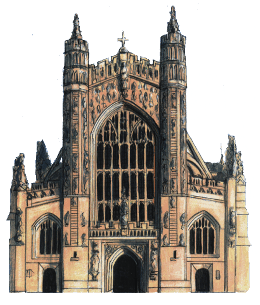 The Catholic church was run by the clergy. Men of them worked as priests in the parish churches - almost every village had it's own church and priests had considerable influence over the people. He could force them to attend church and punish them in the church court if they refused. Priests also collected a tenth of whatever the peasants had produced from their land over the course of the year called a "tithe".
The Catholic church was run by the clergy. Men of them worked as priests in the parish churches - almost every village had it's own church and priests had considerable influence over the people. He could force them to attend church and punish them in the church court if they refused. Priests also collected a tenth of whatever the peasants had produced from their land over the course of the year called a "tithe".
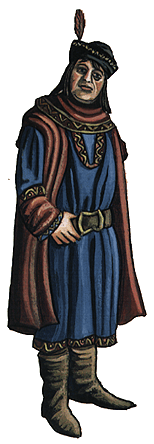 Most country people lived on a manor which consisted of a village, the lord's house or castle, a church and the surrounding farmland. The lord of the manor governed the local community by appointing officials who made sure that the villagers carried out their duties. The lord's main duty, however, was to the king - he was a knight and as such would provide arms to the crown whenever was required.
Most country people lived on a manor which consisted of a village, the lord's house or castle, a church and the surrounding farmland. The lord of the manor governed the local community by appointing officials who made sure that the villagers carried out their duties. The lord's main duty, however, was to the king - he was a knight and as such would provide arms to the crown whenever was required.
 Peasants worked hard every day of their lives except for Sundays and holy days. Bad weather and a typically poor diet meant that most European peasants died before they reached 27. Peasants made some of their own tools and utensils, although skilled craftsmen produced their pottery, leatherwork and iron. Besides wood and leather the most important material was horn from cattle and sheep. Light and strong horn did not absorb flavours like wood and did not require much effort to shape. Horn spoons saved on washing-up because according to one writer "with a little licking they will always be kept as clean as a die".
Peasants worked hard every day of their lives except for Sundays and holy days. Bad weather and a typically poor diet meant that most European peasants died before they reached 27. Peasants made some of their own tools and utensils, although skilled craftsmen produced their pottery, leatherwork and iron. Besides wood and leather the most important material was horn from cattle and sheep. Light and strong horn did not absorb flavours like wood and did not require much effort to shape. Horn spoons saved on washing-up because according to one writer "with a little licking they will always be kept as clean as a die".
 In the towns, women worked in a variety of occupations. They might be shopkeepers, spinners, bakers or "alewives" who brewed ale. Both married and unmarried women were expected to work for a living, Often they would combine several jobs as they were paid less than men.
In the towns, women worked in a variety of occupations. They might be shopkeepers, spinners, bakers or "alewives" who brewed ale. Both married and unmarried women were expected to work for a living, Often they would combine several jobs as they were paid less than men.
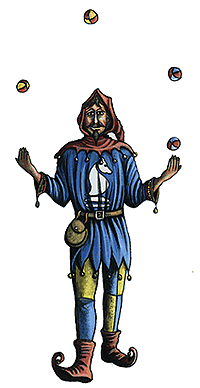 Life in the middle ages was not all hard work! Even the loneliest or poorest peasant could take part in church festivals, join a marriage or funeral procession, or watch and listen to travelling poets, musicians, acrobats and dancers. Perhaps the village would be visited by a troupe leading a performing bear or dancing monkey.
Life in the middle ages was not all hard work! Even the loneliest or poorest peasant could take part in church festivals, join a marriage or funeral procession, or watch and listen to travelling poets, musicians, acrobats and dancers. Perhaps the village would be visited by a troupe leading a performing bear or dancing monkey.
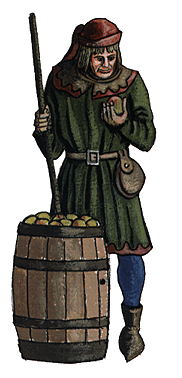 In the beginning a debt could be recorded on a tally stick. Notches were cut into it to record the amount, then the stick was split in two and each party kept half. When the debt was settled the tally was destroyed or kept as a record. As time went on merchants found they needed to keep more accurate accounts of their money and stock. Then traders in 14th century Florence developed a system of double entry book-keeping. Each deal was recorded in the two ledgers - one for the credits and one for the debits. The amounts in each ledger should always balance.
In the beginning a debt could be recorded on a tally stick. Notches were cut into it to record the amount, then the stick was split in two and each party kept half. When the debt was settled the tally was destroyed or kept as a record. As time went on merchants found they needed to keep more accurate accounts of their money and stock. Then traders in 14th century Florence developed a system of double entry book-keeping. Each deal was recorded in the two ledgers - one for the credits and one for the debits. The amounts in each ledger should always balance.
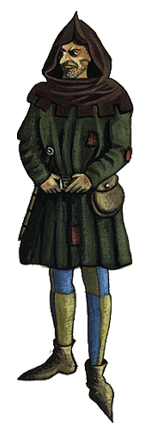 Under feudal law everyone, from the greatest baron to the poorest peasant, owed allegiance to the king. A criminal was someone who, by doing something wrong, "had disturbed the king's peace".
Under feudal law everyone, from the greatest baron to the poorest peasant, owed allegiance to the king. A criminal was someone who, by doing something wrong, "had disturbed the king's peace".


